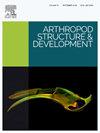A supposedly bioluminescent species of cockroach that would not glow: A case of scientific fraud, erroneous observation or bacterial infection?
IF 1.3
3区 农林科学
Q2 ENTOMOLOGY
引用次数: 0
Abstract
Two reports of the discovery of bioluminescent cockroach species from South America in 1999 and 2003 led to a flurry of speculation on the evolution of the species, the likely function of the light supposedly emitted by the males of the species, and in fact whether these cockroaches were bioluminescent at all. No spectral emission data or biochemical analyses of luciferins or luciferases were available and observations as well as video recordings of the cockroaches failed to record any evidence of an emission of light. Considering the case against the so-called glowspots being able to emit light, it was concluded that the conspicuous spots on the pronotum of the males could play a part in mate choice or serve as a warning signal. Our re-examination of the issue confirms that the spots do not emit light and that, barring the possibility of scientific fraud or confusing fluorescence with bioluminescence, individual cockroaches in the field might have been seen to glow due to an infection with a species of the cosmopolitan bacterial genus Photorhabdus. We were able to show that Photorhabdus luminescens bacteria can colonize specimens of the cockroach Blaptica dubia and there is no reason to doubt that other species of cockroaches could not also become infected by this luminescent insect pathogen.
一种被认为会发光的蟑螂不会发光:是科学欺诈、错误观察还是细菌感染?
1999年和2003年,两份关于在南美洲发现生物发光蟑螂的报告引发了一系列关于物种进化的猜测,该物种雄性发出的光的可能功能,以及这些蟑螂实际上是否具有生物发光性。没有荧光素或荧光素酶的光谱发射数据或生化分析,对蟑螂的观察和录像也没有记录到任何发光的证据。考虑到所谓的发光点能够发光的情况,得出的结论是,雄性前前额的显眼点可能在择偶中起作用,或者作为警告信号。我们对这个问题的重新检查证实,这些斑点不发光,并且,排除科学欺诈或将荧光与生物发光混淆的可能性,野外的个体蟑螂可能是由于感染了一种世界各地的细菌属Photorhabdus而发光的。我们能够证明光habdus luminescens细菌可以在蜚蠊Blaptica dubia的标本中定植,并且没有理由怀疑其他种类的蜚蠊也不会被这种发光昆虫病原体感染。
本文章由计算机程序翻译,如有差异,请以英文原文为准。
求助全文
约1分钟内获得全文
求助全文
来源期刊
CiteScore
3.50
自引率
10.00%
发文量
54
审稿时长
60 days
期刊介绍:
Arthropod Structure & Development is a Journal of Arthropod Structural Biology, Development, and Functional Morphology; it considers manuscripts that deal with micro- and neuroanatomy, development, biomechanics, organogenesis in particular under comparative and evolutionary aspects but not merely taxonomic papers. The aim of the journal is to publish papers in the areas of functional and comparative anatomy and development, with an emphasis on the role of cellular organization in organ function. The journal will also publish papers on organogenisis, embryonic and postembryonic development, and organ or tissue regeneration and repair. Manuscripts dealing with comparative and evolutionary aspects of microanatomy and development are encouraged.

 求助内容:
求助内容: 应助结果提醒方式:
应助结果提醒方式:


